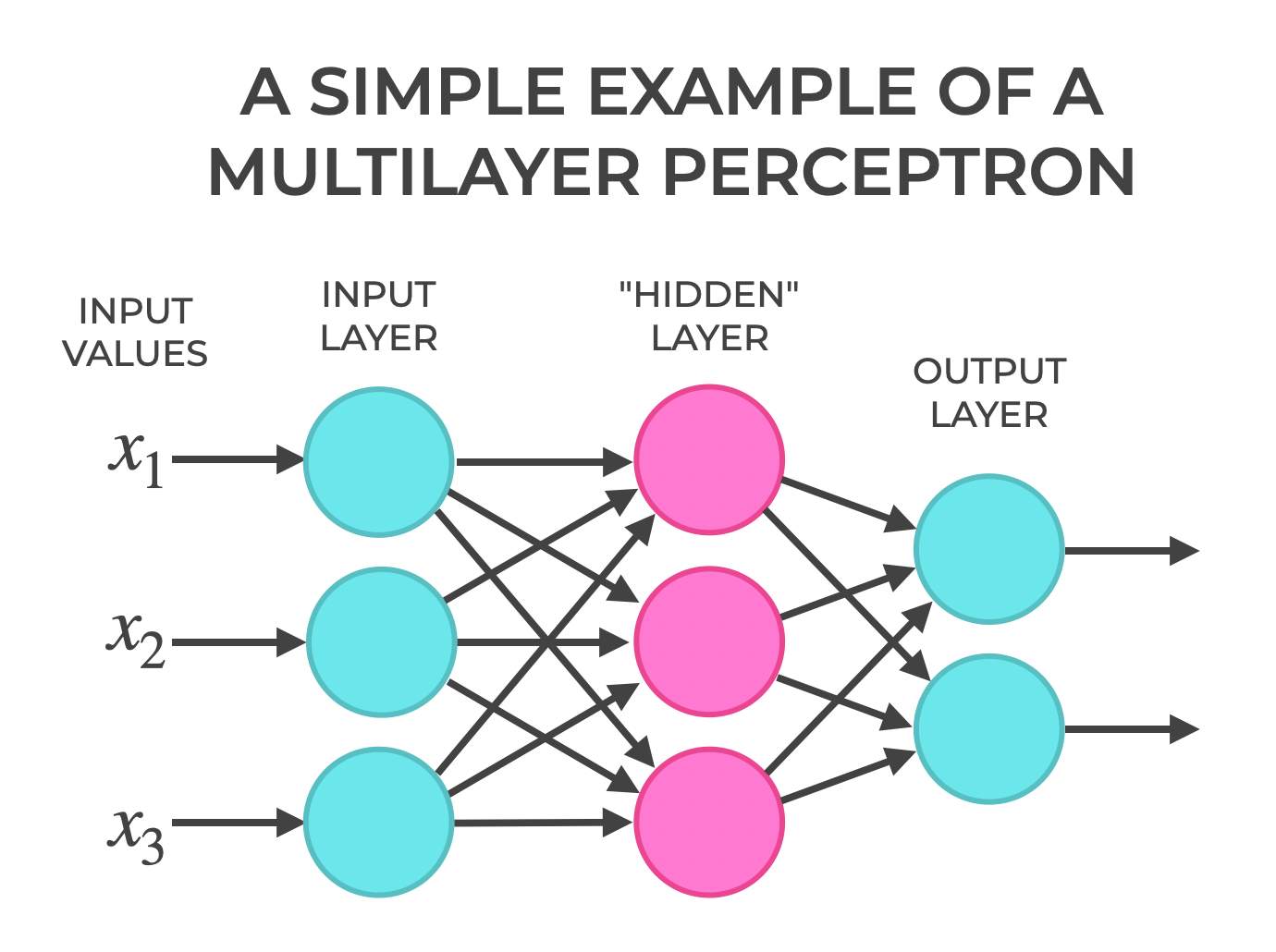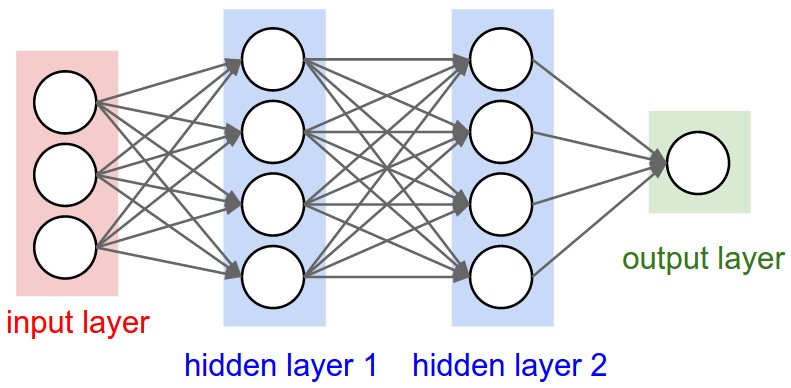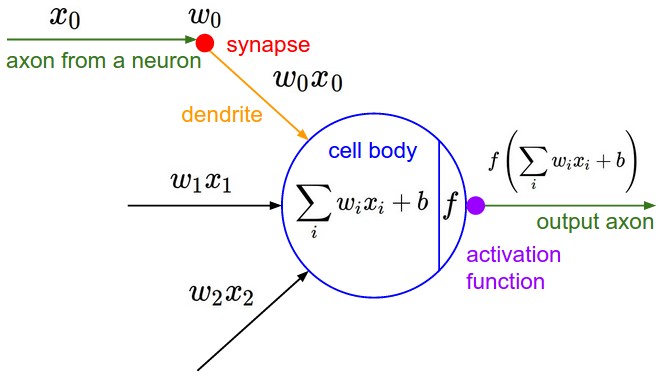Backprop
Course
Andrej Karpathy "Hero to zero" course on nnet:
Derivative
Definition
dxdf=h→0limhf(x+h)−f(x)
Intuition
dxdf=slope of curve f(x)

small change in x (h) -> small change in f
Rules
From limit definition -> derivative rules
dxd(k)dxd(x)dxd(x2)dxd(kxn)dxd(f(x)+g(x))dxd(f(x)g(x))dxd(ex)=0=1=2x=k⋅n⋅xn−1=dxdf(x)+dxdg(x)=f(x)dxdg(x)+g(x)dxdf(x)=ex
Ex:
f(x)dxdf=3x2−4x+5=3⋅2x−4+0=6x−4
Numerical approximation
if h is very small (h≈0):
dxdf≈hf(x+h)−f(x)
Multivariable
multiple variables -> partial derivative, assume other variables are constants.
Ex:
f(x,y,z)∂x∂f∂y∂f∂z∂f=x⋅y+z=y⋅1+0=y=x⋅1+0=x=0+1=1
∂y∂f : how does y influences f ?
small change in y when keep x,z constants -> small change in f
Autodiff / Autograd
- Automatic differentiation
- mathematical expression (function) -> graph of nodes (expression graph)
- forward pass = traverse/eval graph = eval math expression
- compute derivative of function by computing df/dV at each node using numerical differentiation
Ex:
| [a] -> [+] -> [c]
[b] ->
c = a + b
dc/da = ?
dc/da = 1 + 0 = 1
|
impl:
| Value
Value children[2]
operator (+, -, *, /, ^, ...)
grad = 0 (dL/dV)
|
operations on : scalar (1x1), vector (Nx1), matrix(MxN), tensor(MxNxKx...)
- deriv tanh(x) -> 1-tanh(x)^2
- deriv exp(x) = exp(x) = n.value
- a / b = a * 1/b = a * b^-1
- a - b = a + (-b)
Backprop
Backpropagation = wiggle machine to figure out how inputs affect output
- backprop = reversed autodiff
- how to get output from inputs?
- follow gradient -> chain rule
- indep of nnet
| from end node, reverse
calc dL/dV = grad of each node, L = loss function
dL/dL = 1 (base case)
dL/dV
...
|
Chain rule
To find the grad of intermediate nodes (local derivative), we need to use the "chain rule":
dadL=dbdL⋅dadb
Chain rule = product rule, change or variable, convert units
Find dL/da (impact of a on L) knowing dL/b (impact of b on L) and db/da (impact of a on b).
Intuition from wiki:
"If a car travels twice as fast as a bicycle and the bicycle is four times as fast as a walking man, then the car travels 2 × 4 = 8 times as fast as the man."
| c: car
b: bike
w: walk
dc/db = 2
db/dw = 4
dc/dw = ?
dc/dw = (dc / db) * (db / dw) = 2 * 4 = 8
|
Ex:
| [a] -> [+] -> [c]
[b] ->
c = a + b
dc/da = ?
dc/da = 1 + 0 = 1
dL/da = (dL / dc) * (dc / da)
dL/da = (dL / dc) * 1 = dL / dc
=> + node transfers the grad backwards, the grad is the same as previous node
|
Ex:
| [a] -> [*] -> [c]
[b] ->
c = a * b
dc/da = ?
dc/da = a * db/da + b * da/da = b
dc/db = a * db/db + b * da/db = a
dL/da = (dL / dc) * (dc / da) = (dL / dc) * b
dL/db = (dL / dc) * (dc / db) = (dL / dc) * a
=> grad through the * node is previous node grad times the value of the opposite node
|
Implementation
-
reversed topological sort
-
compute grad of each node, apply chain rule repetitively

| topo = []
visited = set()
def build_topo(n):
if n not in visited: # maintain visited set of nodes
visited.add(n)
for child in n.children:
build_topo() # recursion
topo.append(n) # add parent *after* all children have been visited
build_topo(root)
|
Bug
1
2
3
4
5
6
7
8
9
10
11
12 | b = a + a
db/da = 2 != 1
if &a == &a (point to same address)
or
d = a * b
e = a + b
f = d * e
whenever reuse variable more than once
need to accumulate grad not just set it! (must init grad to 0)
|
https://en.wikipedia.org/wiki/Chain_rule#Multivariable_case
Neural networks (nnet)
| input = input data, weights, biases
output = loss
|
backprop -> iterative improve weights to min loss (train nnet):
- gradient points in direction of increasing value
- to min L, take step in direction opposite to gradient
- known as "gradient descent", optimization problem
Impl
1
2
3
4
5
6
7
8
9
10
11
12
13
14
15
16
17 | Neuron
ctor: init w,b to [-1,1]
call: Wx+b, # forward()
parameters() list of w + b
zip(a,b) # zip a with b, pair each element of a and b together
sum(v, init value)
Layer = N indep Neuron
MLP = N layers
parameters()
flat list of all parameters (w,b)
Module
zero_grad()
parameters()
x = [2.0, 3.0, -1.0]
nn = MLP(3, [4,4,1])
nn(x)
|
train nnet with gradient descent
1
2
3
4
5
6
7
8
9
10
11
12
13
14
15
16
17 | for t in epochs
# forward
ypred = nn(x)
loss = MSE(ypred, yref)
# flush grad
p.zero_grad()
for p in nn.parameters()
p.grad = 0.0
# backward
loss.backward()
# update
# optimizer.step()
for p in nn.parameters()
learning_rate = 0.01 # not too big (unstable, !converge), not too small (slow)
p.data += learning_rate * -p.grad
|
- learning rate decay, shrink over time
1.0 - 0.9/100*t
Loss function
measure perf of nnet:
- MSE =
sum((y - yref)^2)
- cross entropy
- binary cross entropy
- negative log likelihood (-log(softmax(x))), logit
- max margin loss
micrograd vs PyTorch
- similar API
- much smaller, ~200lines of python!
- scalar vs tensor = optimization
PyTorch
| import torch
x1 = torch.Tensor([2.0]) # create tensor
x1 = x1.double() # cast (default type = f32)
x1.requires_grad = True # leaf nodes (default = no grad)
x1.shape # get dimensions
x1.dtype # get type
x2 = torch.Tensor([3.0])
x3 = torch.tanh(x1 + x2) # exec operations
x3.data.item() or x3.item() # get value (.item() returns value, strips out tensor)
x3.grad.item() # get grad
x3.backward() # run backprop
|
Python tricks
__repr__ vs __str__ : str is for making it look good, repr is for making it accurate (debug)__rmul__ : 1 * object__truediv__ : a / b__pow__ : a^n- format string
"some {.4f} value".format(var)f"some {var} value""%.4f" % var
- put 2 lines on 1 :
line 1; line 2
_private_method()- use
_ as unused variable name
Includes
| import math
import numpy as np
import matplotlib.pyplot as plt
%matplotlib inline # plot immediately after running plt.plot() (jupyter notebook)
|
Draw graph of nodes
1
2
3
4
5
6
7
8
9
10
11
12
13
14
15
16
17
18
19
20
21
22
23
24
25
26
27
28
29
30
31
32 | from graphviz import Digraph
def trace(root):
nodes, edges = set(), set()
def build(v):
if v not in nodes:
nodes.add(v)
for child in v._prev:
edges.add((child, v))
build(child)
build(root)
return nodes, edges
def draw_dot(root, format='svg', rankdir='LR'):
"""
format: png | svg | ...
rankdir: TB (top to bottom graph) | LR (left to right)
"""
assert rankdir in ['LR', 'TB']
nodes, edges = trace(root)
dot = Digraph(format=format, graph_attr={'rankdir': rankdir}) #, node_attr={'rankdir': 'TB'})
for n in nodes:
dot.node(name=str(id(n)), label = "{ data %.4f | grad %.4f }" % (n.data, n.grad), shape='record')
if n._op:
dot.node(name=str(id(n)) + n._op, label=n._op)
dot.edge(str(id(n)) + n._op, str(id(n)))
for n1, n2 in edges:
dot.edge(str(id(n1)), str(id(n2)) + n2._op)
dot.render('gout')
|




